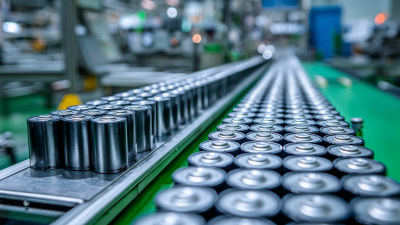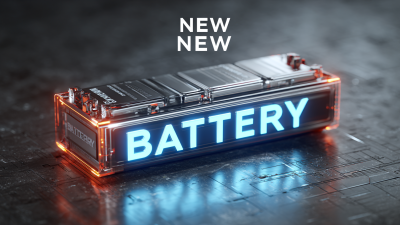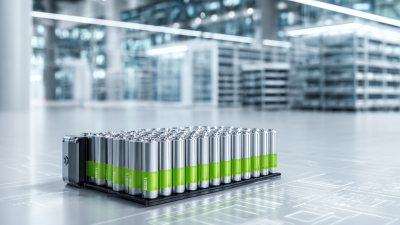Unveiling the Future: Breakthroughs in Latest Battery Technology You Need to Know About
As we stand on the brink of a technological revolution, the importance of the latest battery technology cannot be overstated. This pivotal field is experiencing unprecedented breakthroughs that promise to reshape everything from consumer electronics to renewable energy storage. In an era where sustainability and efficiency are paramount, innovators are exploring new materials, architectures, and chemistries that enhance energy density, charging speed, and lifespan. These advancements not only propel electric vehicles towards greater adoption but also offer solutions to global energy challenges, making clean energy sources more viable. In this comprehensive exploration, we will delve into the most exciting innovations and trends in the realm of battery technology, providing insights into how these developments will influence our daily lives and drive us toward a more sustainable future.

The Rise of Solid-State Batteries: Revolutionizing Energy Storage Efficiency
The rise of solid-state batteries marks a pivotal moment in the evolution of energy storage, particularly for electric vehicles (EVs). These advanced batteries utilize a solid electrolyte instead of the traditional liquid alternative, significantly enhancing safety and energy density. Recent advancements indicate that solid-state batteries could enable EVs to achieve ranges exceeding 500 miles by 2028, thus addressing one of the major concerns for potential EV buyers: range anxiety. Researchers have developed innovative nickel-rich cathodes that not only improve battery efficiency but also maintain up to 80% capacity after 300 cycles, leading to prolonged lifespans.
Moreover, the integration of artificial intelligence in the screening and performance assessment of solid-state battery materials promises to accelerate the development of next-generation energy storage solutions. Innovations in solid electrolytes and new materials are set to overcome existing limitations, facilitating faster charging times and enhancing overall battery efficiency. The potential of solid-state batteries to revolutionize not only the EV market but also broader energy storage applications is becoming increasingly tangible, making them a focal point in the quest for sustainable energy solutions.

Understanding Lithium-Sulfur Batteries: Unlocking Higher Energy Density Potential
Lithium-sulfur batteries are emerging as a game-changing technology in the quest for higher energy density solutions. With the potential to exceed the energy density of traditional lithium-ion batteries significantly, lithium-sulfur batteries can deliver up to five times more energy per weight. This breakthrough not only enhances performance in various applications, from electric vehicles to portable electronics, but also promises a greener alternative due to the abundance of sulfur and lower toxicity compared to conventional materials.
However, the path to widespread adoption of lithium-sulfur technology is not without challenges. One major hurdle lies in the cycle life of these batteries, which tends to be shorter than their lithium-ion counterparts due to issues like polysulfide dissolution. To optimize performance, researchers are focusing on advanced materials and innovative designs that can stabilize the battery chemistry and enhance durability.
**Tips:**
- When considering a transition to lithium-sulfur technology, keep an eye on emerging research that addresses cycle life improvements.
- For consumers, look for products that emphasize sustainable battery technology, as lithium-sulfur may soon become a leading choice in eco-friendly energy solutions.
- Stay informed about innovations in battery management systems, which can further optimize the efficiency and lifespan of lithium-sulfur batteries in practical applications.
Energy Density Comparison of Various Battery Technologies
This chart illustrates the energy density potential of various battery technologies, showcasing the advancements in lithium-sulfur batteries compared to traditional lithium-ion and other emerging technologies. The higher energy density of lithium-sulfur batteries presents significant advantages for future applications.
The Role of Graphene in Enhancing Battery Performance and Sustainability
Recent advancements in battery technology have underscored the critical role of graphene in revolutionizing energy storage systems. According to a report by IDTechEx, the graphene battery market is anticipated to reach $2.6 billion by 2027, demonstrating a compound annual growth rate (CAGR) of 45%. This remarkable growth is largely attributed to graphene’s unique properties, such as its high conductivity and large surface area, which dramatically enhance the energy density and charge/discharge rates of batteries. As manufacturers increasingly incorporate graphene into lithium-ion and solid-state batteries, performance metrics are seeing significant improvements, driving both efficiency and sustainability in energy storage.
Tip: When considering new battery technologies, examine the materials used in production. Graphene-enhanced batteries not only provide better performance but can also lead to longer battery lifespans, reducing waste over time.
Additionally, the use of graphene helps in addressing environmental concerns related to battery production and disposal. A study published in the Journal of Energy Storage revealed that integrating graphene can reduce the need for rare and toxic materials often found in traditional batteries. This shift not only lowers environmental impact but also presents opportunities for greener manufacturing processes. As the industry moves toward sustainable practices, the adoption of graphene is set to play a pivotal role in the future of energy solutions.
Tip: Stay informed about the latest innovations in battery technology to make eco-conscious choices. Opting for products with graphene-enhanced batteries can contribute to a more sustainable energy ecosystem.
Exploring Fast-Charging Technologies: Reducing Charge Times by Up to 70%
The race for faster charging technologies is accelerating, with innovations poised to reduce charging times by up to 70%. Industry experts predict that 2025 will be a pivotal year, marking a significant shift with the introduction of ultra-fast charging solutions. A recent report highlights how new materials, specifically silicon-based anodes, can greatly enhance charging efficiency while improving the overall lifecycle of batteries. This transition is crucial as EV adoption surges, with the International Energy Agency forecasting that there will be over 145 million electric vehicles on the road by 2030.
Cutting-edge developments, such as a new battery design claiming to add over 320 miles of range in just five minutes of charging, showcase the potential of advanced battery technology. As manufacturers continue to invest in ultra-fast charging infrastructure, we are likely to see a transformative impact on consumer behavior and the automotive landscape. The increasing deployment of high-capacity charging stations is anticipated to make electric vehicles more attractive to a broader audience, fundamentally shifting public perception and usage of electric mobility in the near future.
Unveiling the Future: Breakthroughs in Latest Battery Technology You Need to Know About
| Technology Type | Charge Time Reduction | Energy Density (Wh/kg) | Cycle Life (Charge/Discharge) | Temperature Tolerance (°C) |
|---|---|---|---|---|
| Lithium Titanate | Up to 70% | 100 | 10,000 | -40 to 60 |
| Solid State Batteries | 60% | 300 | 1,000 | -20 to 70 |
| Lithium Sulfur | 50% | 500 | 300 | -30 to 60 |
| Graphene Batteries | 65% | 250 | 1,500 | -20 to 70 |
The Future of Recyclable Batteries: Mitigating Environmental Impact and Waste
The future of battery technology is increasingly focused on sustainability, particularly through the development of recyclable batteries that aim to mitigate environmental impact and waste. According to a report by the International Energy Agency (IEA), the global demand for batteries is expected to increase by nearly 30 times by 2030, driven largely by the rise of electric vehicles and renewable energy storage solutions. This surge presents a significant challenge in managing battery waste, which could reach 12 million tons per year by 2030 if current manufacturing practices continue.
Innovations in recyclable battery technology are already underway. Companies like Redwood Materials are working to create closed-loop systems to recover valuable materials from used batteries, such as lithium, cobalt, and nickel. These metals can be reused in new batteries, reducing the need for mining and its associated environmental degradation. A study conducted by the Battery Innovation Center revealed that properly recycled lithium-ion batteries can recover up to 95% of their raw materials, which not only conserves resources but also decreases greenhouse gas emissions associated with battery production by up to 65%. The transition to a more circular economy in battery manufacturing is crucial for sustainable growth in this rapidly evolving industry.

Related Posts
-

Top Strategies for Leveraging Best New Battery Technology in Your Business
-

The Ultimate Guide to Choosing the Right Storage Battery for Your Needs
-

Navigating Import Export Certifications for the Leading Battery Manufacturers
-

Your Essential Guide to the Latest Innovations in Battery Technology
-

How to Harness the Advantages of Best New Battery Technology for Your Business
-

Explore the Top Choices for Best Solar System Batteries in 2023
